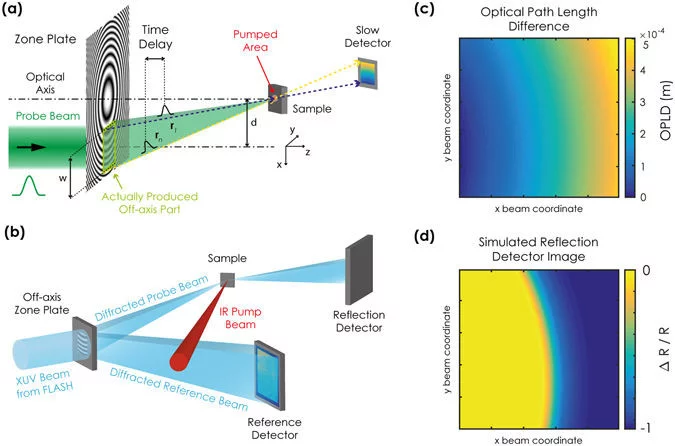In collaboration with the Sorbonne Universités, HASYLAB/DESY, Synchrotron SOLEIL, CNRS, and Uppsala University, we have developed a novel experimental method that allows retrieving with a single X-ray pulse the time evolution of an ultrafast process continuously over an extended time window [1]. The technique is based on the fact that the focusing with a Fresnel Zone plate results in a difference in arrival time of the rays close to the optical axis with respect to those far away from the axis. The measurements were performed at the X-ray free electron laser FLASH, were we used a single X-ray pulse to resolve the laser-induced ultrafast demagnetisation dynamics in a thin cobalt film over a time window of about 1.6 ps with an excellent signal to noise ratio. From one representative single shot measurement we extract a spin relaxation time of (130 ± 30) fs with an average value, based on 193 single shot events of (113 ± 20) fs. These results are limited by the achieved experimental time resolution of 120 fs, and both values are in excellent agreement with previous results and theoretical modelling. More generally, this new experimental approach to ultrafast X-ray spectroscopy paves the way to the study of non repetitive processes that cannot be investigated using traditional repetitive pump-probe schemes.
In an experiment at the DiProI beamline at FERMI, we extended the X-ray streaking method to investigate the demagnetization dynamics of two different elements, simultaneously [2]. Using a two color off-ais zone plate, in combination with the two color emission of the FERMI XFEL, an international scientific team performed such an experiment on an iron-nickel composite magnetic film. The measurements allowed for the first time to follow the response separately for both magnetic elements with perfect relative timing. It unambiguously revealed a delay of approximately 100 fs between the magnetic response with respect to the electronic excitation. This delay shows that the electronic and spin degrees of freedom are decoupled during the demagnetization process. Furthermore, the electronic dynamics of Ni and Fe show pronounced differences when probed at their respective resonance while the demagnetization dynamics are similar. These observations underline that complex materials may have completely different electronic and magnetic behavior than the pure elements they consist of.
Publications
- M. Buzzi, M. Makita, L. Howald, A. Kleibert, B. Vodungbo, P. Maldonado, J. Raabe, N. Jaouen, H. Redlin, K. Tiedtke, P. M. Oppeneer, C. David, F. Nolting, and J. Lüning. Single-shot Monitoring of Ultrafast Processes via X-ray Streaking at a Free Electron Laser, Scientific Reports 7, 7253 (2017)
- B. Rösner, B. Vodungbo, V. Chardonnet, F. Döring, V. A. Guzenko, M. Hennes, A. Kleibert, M. Lebugle, J. Lüning, N. Mahne, A. Merhe, D. Naumenko, I. P. Nikolov, I. Lopez-Quintas, E. Pedersoli, P. R. Ribič, T. Savchenko, B. Watts, M. Zangrando, F. Capotondi, C. David, E. Jal. Simultaneous two-color snapshot view on ultrafast charge and spin dynamics in a Fe-Cu-Ni tri-layer, Structural Dynamics, 7 (2020) 054302.



